
94% of researchers rate our articles as excellent or good
Learn more about the work of our research integrity team to safeguard the quality of each article we publish.
Find out more
ORIGINAL RESEARCH article
Front. Astron. Space Sci., 31 May 2019
Sec. Stellar and Solar Physics
Volume 6 - 2019 | https://doi.org/10.3389/fspas.2019.00041
This article is part of the Research TopicThe Future of AsteroseismologyView all 19 articles
Magnetic activity changes the gravito-acoustic modes of solar-like stars and in particular their frequencies. There is an angular-degree dependence that is believed to be caused by the non-spherical nature of the magnetic activity in the stellar convective envelope. These changes in the mode frequencies could modify the small separation of low-degree modes (i.e., frequency difference between consecutive quadrupole and radial modes), which is sensitive to the core structure and hence to the evolutionary stage of the star. Determining global stellar parameters such as the age using mode frequencies at a given moment of the magnetic activity cycle could lead to biased results. Our estimations show that in general these errors are lower than other systematic uncertainties, but in some circumstances they can be as high as 10% in age and of a few percent in mass and radius. In addition, the frequency shifts caused by the magnetic activity are also frequency dependent. In the solar case this is a smooth function that will mostly be masked by the filtering of the so-called surface effects. However, the observations of other stars suggest that there is an oscillatory component with a period close to the one corresponding to the acoustic depth of the He II zone. This could give rise to a misdetermination of some global stellar parameters, such as the helium abundance. Our computations show that the uncertainties introduced by this effect are lower than the 3% level.
Stars located below the instability strip in the Hertzsprung-Russell diagram have external convective zones and are usually called solar-like stars. Turbulent motions inside these convective layers excite gravito-acoustic modes (Goldreich and Keeley, 1977) that are used in asteroseismology to characterize the internal structure and dynamics of the stars. With the development of continuous (from months to years) high-precision photometry from space with several missions such as CoRoT (Baglin et al., 2006), Kepler (Borucki et al., 2010), K2 (Howell et al., 2014), and TESS (Ricker et al., 2014) hundreds of main-sequence stars and dozens of thousands red giants have been observed.
For many of these solar-like stars, the fundamental parameters have been estimated using the seismic measurements. Using the so-called “global asteroseismic scaling relations” (e.g., Brown et al., 1991; Kjeldsen and Bedding, 1995; Chaplin et al., 2011), masses and radii are obtained with a typical precision of 10 and 5%, respectively (e.g., Kallinger et al., 2010). These estimates are model-independent because they rely on three observables: the effective temperature of the star, Teff, the frequency of the maximum power where the modes are located, νmax, and the large frequency spacing, Δν. The observed data from the Sun and other stars are used as references. Better results can be obtained using stellar models to derive mass, radius, and also age. In the case of grid-based modeling, when fitting spectroscopic observables and global seismic parameters all together to a pre-calculated grid of models, we can reach a precision better than 3% in radius, 6% in mass, and 23% in age (Serenelli et al., 2017). The improvement is even better when incorporating the information from the individual mode frequencies with systematic uncertainties of 1% in radius, 3% in mass, and 15% in age (e.g., Mathur et al., 2012; Lebreton et al., 2014a,b; Metcalfe et al., 2014; Silva Aguirre et al., 2015; Creevey et al., 2017).
The precision reached by the asteroseismic inferences when the information of the individual modes is used, is among the best for field stars. Therefore, they are particularly interesting for other research fields such as galactic-archaeology studies (e.g., Miglio et al., 2013, 2015; Anders et al., 2016) as well as to properly characterize the exoplanet radius through the transit method (e.g., Huber et al., 2013; Van Eylen et al., 2018a,b).
The combined action of convection and differential rotation in main-sequence solar-like stars can produce magnetic fields of dynamo origin (e.g., Brun and Browning, 2017). Under the action of stellar winds, stars of masses below ~ 1.4M⊙ slow down during their evolution (e.g., Skumanich, 1972; Kawaler, 1988; Matt et al., 2012; García et al., 2014; Réville et al., 2015). Sometimes, these magnetic fields change regularly, producing magnetic cycles similar to the 11-year cycle of the Sun in which the poles change polarity, requiring 22 years to complete a full magnetic cycle. The perturbations induced by the magnetic fields modify the properties of the acoustic modes measured in the Sun (e.g., Woodard and Noyes, 1985; Pallé et al., 1989; Broomhall et al., 2014) and in other stars (e.g., García et al., 2010; Salabert et al., 2016; Kiefer et al., 2017; Karoff et al., 2018; Santos et al., 2018). In particular, mode frequencies are shifted toward higher frequencies as the magnetic cycle evolves toward the maximum activity.
The shifts in the mode frequencies can introduce systematic errors in the inferred global stellar parameters, specially if the star is only observed during the maximum of an on-going magnetic activity cycle. However, if the frequency shifts induced by the magnetic field smoothly increase with the frequency, as it is in fact the dominant change in the Sun, this effect will be partially or perhaps mostly masked by the filtering of the so-called surface effects (see Howe et al., 2017 where the time variation in the surface term due to the solar activity cycle was analyzed in detail).
Such filtering is required at present in any model fitting procedure to deal with the unknown physics of the upper layers of the star (e.g., Kjeldsen et al., 2008; Ball and Gizon, 2017). This is perhaps one of the reasons why these potential systematic uncertainties have not drawn great attention to the asteroseismic community.
However, there are additional terms in the frequency shifts induced by the magnetic activity, already present in the Sun and that seem to be more important in other stars. As it is going to be described below, the magnitude of the shifts in some stars not only are much larger than in the Sun but the shifts of the different low-degree modes are clearly different. This can introduce a bias in the stellar parameter determination. Moreover, as uncovered by Salabert et al. (2018), in some stars the variation of the frequency shifts with frequency does not follow a simple smooth function but has a more sinusoidal shape, suggesting that the magnetic perturbation is occurring in deeper layers compared to the Sun. This frequency changes are not filtered with the surface correction terms.
In this paper we study the impact of both effects in the extraction of the global stellar parameters providing additional uncertainties that takes into account these biases induced by the magnetic field on the frequencies. The observed and simulated data used are described in section 2 whereas in section 3 we explain in detail the frequency shifts considered in this work. In section 4 we describe the methodology used to perform the model fitting. The results are discussed in section 5 and some conclusions are presented in section 6.
We have selected two main-sequence stars studied by Salabert et al. (2018) and that show frequency changes due to magnetic activity. The first one is KIC8006161 that has about 1M⊙ and a radiative core. The second one is KIC9139163 which is a more massive star, of about 1.4M⊙, and presumably with a convective core. The former star seems an ideal choice for a solar analog because it has a large range of detected modes, including some ℓ = 3, and it shows frequency changes correlated with the photometric magnetic activity that depends on angular degree ℓ (Santos et al., 2018) and frequency ν (Salabert et al., 2018). The frequency range of the acoustic modes detected in KIC9139163 is smaller, but it corresponds to the typical number of modes we have for an F8 main-sequence star without mixed modes. This star is still perfect for our analysis as it shows both angular degree and frequency dependent shifts (see Santos et al., 2018; Salabert et al., 2018, respectively). The spectroscopic parameters and frequency sets used for both stars are given in Table 1. For KIC8006161 the full set of frequencies reported by Appourchaux et al. (2012) includes ℓ = 0 modes with radial orders in the range n = 15−30, ℓ = 1 modes with n = 13−29, ℓ = 2 modes with n = 15−29 and ℓ = 3 modes with n = 19−24. For KIC9139163 the range of frequencies considered was: ℓ = 0, n = 11−29, ℓ = 1, n = 11−29, and ℓ = 2, n = 10−28. The values of the frequency of maximum power νmax and the large separation Δν were not used in the fitting procedure but are indicated in Table 1 for guidance.
The effect or bias that magnetic activity can introduce on the determination of the fundamental stellar parameters will be influenced by the observational constraints (spectroscopic and asteroseismic inputs) and the stellar evolution and oscillation codes considered (underlying physics, free parameters considered, etc.). Since observations and theoretical models can be improved in the near future we have found convenient to partially remove such effects by considering in addition to the real stars, two models as proxy stars. They are constructed from the best-fit model for each star (obtained as indicated in section 4). We used the output of the best-fit model as input parameter for computing the frequencies of the corresponding proxy star. In the minimization procedure the same set of (n, ℓ) modes were considered. Although these proxies will be free of systematic errors other than the bias introduced by the frequency shifts from the simulated magnetic activity (to be discussed in the next section), assuming these targets free of observed errors would be unrealistic. So we have adopted the criteria described below.
Considering the theoretical frequencies for the proxies would assume that near-future models will introduce systematic errors much lower than the observed ones. Presumably this would not be the case due to the complex physics required to model the upper layers both in the stellar structure models and in the oscillation laws for sonic, turbulent, non-adiabatic motions. Although some progress has already been done for improving the physics of the uppermost layers (e.g., Trampedach et al., 2017), we can only expect that in the coming years surface effects would introduce diminished discrepancies between theoretical and observational frequencies, but remaining higher than the observational errors. Hence it is convenient that our proxy stars include some departure from the models which gives rise to similar surface effects. In particular we computed the eigenfrequencies of the proxy stars with a different surface boundary condition, namely δP = 0 rather than the standard match to the analytical solution for an isothermal atmosphere at the top of the model. Blue points in Figure 1 correspond to the differences between the proxy stars (the same models with δP = 0 as boundary condition) and the model frequencies (computed with the standard boundary conditions). Upper panel is for KIC8006161 and bottom panel for KIC9139163. As expected these differences show a typical smooth frequency function with δω → 0 as ω → 0 as any other surface effect. In the same figure we have compared such effect with the surface terms found for the actual stars after the standard model fit procedure detailed in the section 4 was carried out. The red points correspond to the differences between the observed frequencies and the ones from the best models. Note that in our simulation the surface errors are of opposite sign but we have not found any indication of this being relevant in the final results.
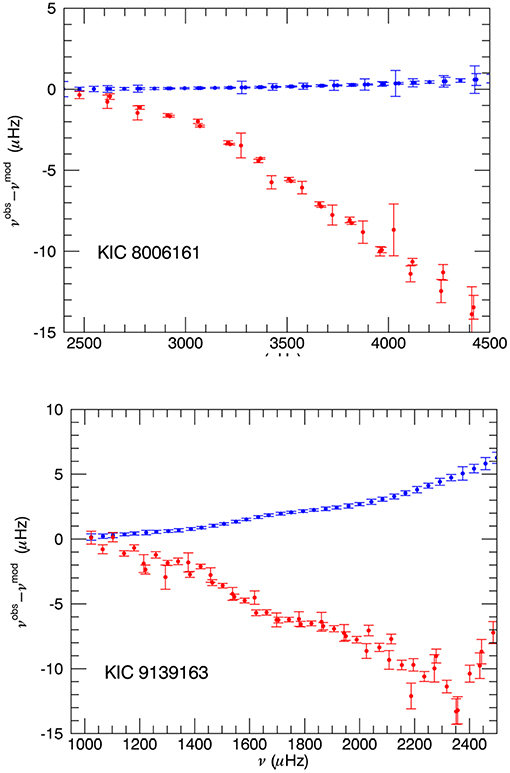
Figure 1. Frequency differences between the observations (resp. proxy stars) and the best-fit model are represented with the red symbols (resp. blue symbols). The differences for the proxy stars are due to the different boundary conditions used, as detailed in section 2.
Regarding the frequency errors in the proxies we have considered two cases: one case with the observed errors and the other one with half of the errors. Similarly, theoretical spectroscopic parameters were used but with errors half the observed ones for each star; these inputs are indicated in Table 1. The error in the frequencies are given by a combination of the frequency resolution, the signal-to-noise ratio of the spectrum, and the width of the modes (see e.g., Libbrecht, 1992; Toutain and Appourchaux, 1994). Maintaining the width and the SNR constant the error will be reduced as where T is the length of the observations. Thus, to reduce the error by a factor of 2, it is necessary to measure four times longer.
In Santos et al. (2018), temporal variations of the mode frequencies were measured for 87 solar-like stars observed by Kepler. Significant frequency shifts were found for more than half of the stars. Within the sample, the observed absolute frequency shifts vary between 0 and 2.2μHz with a median value of 0.15μHz.
As modes of different angular degree are sensitive to different latitudes and, in principle, magnetic activity is not uniformly distributed over the stellar surface, the frequency shifts for the radial and non-radial modes are not expected to be the same. In fact based on the results of Santos et al. (2018), the difference between the frequency shifts for l = 0 and l = 1 modes is found to increase with effective temperature. However, we note that the mode frequencies are less accurately determined for hotter stars than cooler stars. Also, generally, the number of visible modes decreases with effective temperature. Figure 2 shows the median difference in the frequency shifts as a function of the effective temperature for the 87 Kepler targets. The stars KIC8006161 and KIC9139163 are highlighted as they are the focus of this study.
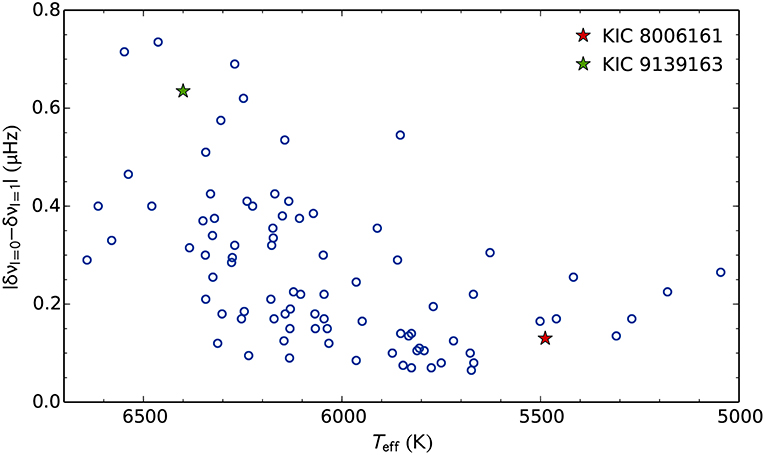
Figure 2. Median absolute difference between the frequency shifts for l = 0 and l = 1 modes, |δνl = 0−δνl = 1|, as function of the effective temperature, Teff for the 87 solar-like stars in Santos et al. (2018). The red and green stars mark KIC8006161 and KIC9139163 respectively.
Figure 3 shows frequency shift differences between radial and non-radial modes as a function of time for the two stars considered in this work. Data were taken from Santos et al. (2018). The red points correspond to the difference between the frequency shifts of l = 0 and l = 1 modes whereas the blue points are the difference between the l = 0 and l = 2 modes. Although not shown in the figure, we note that for KIC8006161 the mean frequency shift of the radial oscillations remains almost constant in the first half of the observed period (for the first 800 days) and then monotonically increases with time (where magnetic activity is increasing). From Figure 3 it seems that at this later stage of the activity cycle the shifts of the non-radial modes are systematically higher than the radial ones by tenths of μHz whereas in the first period the shift of the non-radial modes is similar or lower than for the radial ones. As shown in Figure 2 the range in the median differences between the shifts of the l = 0 and l = 1 modes for KIC9139163 is higher, but from Figure 3 we can see that the periods when the non-radial shifts remain systematically higher or systematically lower than the radial ones are shorter. As a conclusion we can expect that frequency modes determined from observed periods of few hundreds of days can introduce differences in the frequency shifts between radial and non-radial modes of a few tenths of μHz.
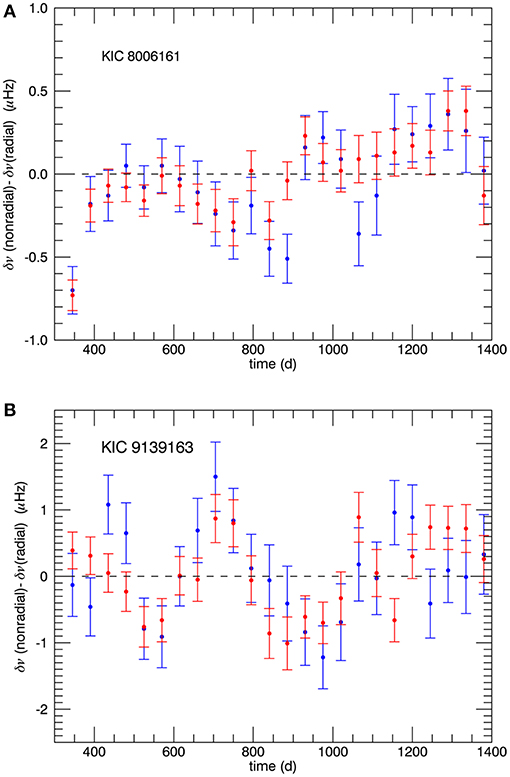
Figure 3. Frequency shift differences δν(ℓ = 1)−δν(ℓ = 0) (red points) and δν(ℓ = 2)−δν(ℓ = 0) (blue points) as a function of time (in days) for KIC8006161 (A) and KIC9139163 (B).
We have considered two different kinds of frequency shifts that can bias the determination of the stellar parameters based on standard stellar codes. The first one is a frequency-dependent shift. As indicated in the introduction this kind of shift was observed in the Sun long time ago but has also been detected in other stars. In the Sun, the frequency dependence of the normalized frequency shifts Inlδνnl where Inl is the mode inertia of the mode with radial order n and degree l (see Aerts et al., 2010 for a definition of mode inertia), has a dominant smooth term, and hence its effects on the determination of the model parameters will be mostly masked by the filtering of the unknown surface term. However, as commented before, following the work by Salabert et al. (2018), in other stars there are some indications that the frequency dependence could include an oscillatory term with a period that could correspond to the acoustical depth of the He II zone. This term in general is not filtered out in the model fitting procedure.
To introduce these frequency shifts in our simulation we follow (Salabert et al., 2016) and (Salabert et al., 2018) and consider a fit to the observed normalized frequency shifts of the form
where ω = 2ν is the angular frequency and τ the acoustical depth representative of the perturbation induced by the magnetic activity. Mode inertias Inl are interpolated from the best-fit models. In principle there are a total of four parameters to be fitted A0, A1, τ, and φ. However, to minimize the errors, the mean values of the frequency shifts between adjacent l = 0 and l = 1 modes were considered in Salabert et al. (2018) and here we proceed in the same way. As a consequence of the small number of frequencies available, determining τ strongly depends on the initial values considered. Therefore, the parameter τ was fixed to τHeII, the acoustic depth of the He II ionization zone given in Table 2 for each star, and, hence, a simple linear fit with the parameters A0, A1, and φ was considered. The normalized frequency shifts thus corrected by the mode inertia were shown in Figure 10 of Salabert et al. (2018) for KIC8006161 and other stars. We show in Figure 4 the absolute frequency shifts, δν, for our target stars (red points with yerror bars). The range of frequencies for which frequency shifts could be determined in Salabert et al. (2018) is much smaller than the full set of frequencies used in the modeling and indicated above. Hence, we extrapolate the function given by Equation (1) to the full range of observed frequencies, resulting in the shifts represented by the black points in Figure 4.
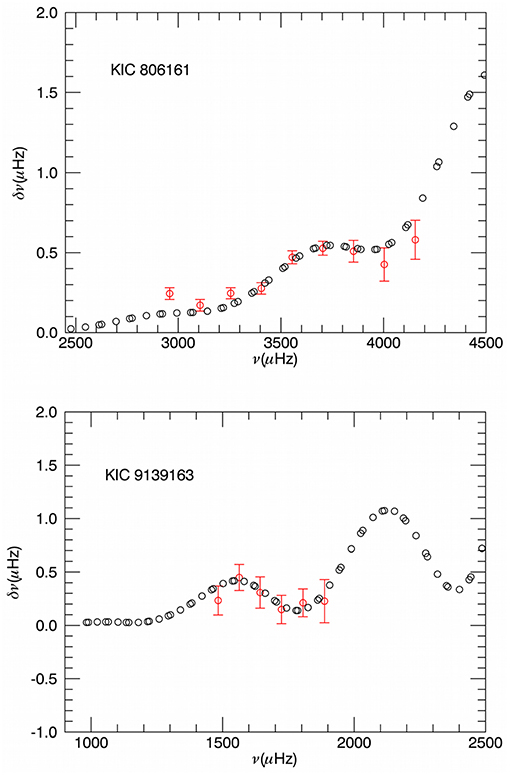
Figure 4. Frequency-dependent shifts introduced in the simulations for both stars. Red symbols are the observed frequency differences computed as reported in Salabert et al. (2018) for KIC8006161 whereas black symbols correspond to the full observed mode set used in the modeling.
We should be aware that the frequency shifts derived from the Kepler mission correspond to differences between the maximum and minimum of the magnetic activity observed in the Kepler data, hence, they do not necessarily correspond to differences between maximum and minimum of the stellar activity cycle. In order to consider different situations, we have taken changes in the amplitude of the oscillation component from −5A1 to 5A1, A1 being the value derived from the fit for each star as given in Equation (1). In section 5, where we show the results, we will see that the highest amplitudes turn out to be very large, but they cannot be rejected a priori.
The second kind of frequency shifts considered is an ℓ-dependent frequency shift consistent with the observed values shown above. Specifically, in our simulation we have assumed that the observations are done at a given moment of the magnetic activity cycle with a time duration of at least several months. Here we add an ℓ-dependent frequency shift δνℓ to the term δνnℓ = A0νnl/Inl defined in Equation (1) and representing an overall frequency increase with magnetic activity. We consider different cases, each one with a constant shift of δν = 0.2fμHz for the ℓ = 0 and δν = −0.1fμHz for the non-radial oscillations, where f is a free parameter that goes from −1.5 to 1.5. This means that in the simulation the difference between the radial and non-radial frequency shifts can be as large as ±0.45μHz. As noted above for a hot star like KIC9139163 the shifts can be even higher (larger than 1μHz) but such differences should be partially averaged out if periods longer than about 100 days are considered.
Model fitting is based on a grid of stellar models evolved from the pre-main sequence to the TAMS using the MESA code (Paxton et al., 2011, 2013, 2015), version 10398. The OPAL opacities (Iglesias and Rogers, 1996), the GS98 metallicity mixture (Grevesse and Sauval, 1998) and the exponential prescription for the overshooting given by Herwig (2000) were used, otherwise the standard input physics from MESA was applied. Eigenfrequencies were computed in the adiabatic approximation using the ADIPLS code (Christensen-Dalsgaard, 2008).
As specifically implemented in MESA, the overshooting formulation corresponds to that introduced by Herwig (2000) and it is a simplified version of the formulation given by Freytag et al. (1996). Here the overshooting parameter fov is defined by the equation
where Dov is the diffusion coefficient, D0 the diffusion coefficient at the transition layer between the standard convection zone and its overshooting extension, z is the distance from this transition layer, Hv the velocity scale height of the overshooting convective elements at z = 0, and Hp the pressure scale height at the same point. To establish the transition layer, first the Schwarzschild criterium is used to determine the edge of the convection zone and then the z = 0 point is shifted a radius 0.01Hp (or fovHp/2 if fov < 0.02) into the convection zone where D0 is computed. From z = 0 and toward the radiative zone, the overshooting formulation is used.
For convective cores lower than 0.001 stellar masses overshooting is never added. The same fov value was used for the core and the envelope and throughout the evolutionary sequence.
Different grids of models were used for each star. For KIC8006161 (and the related proxy) the grid is composed of evolution sequences with masses M from 0.94M⊙ to 1.06M⊙ with a step of ΔM = 0.005M⊙, initial abundances [M/H] from −0.12 to 0.40 with a step of 0.05 and mixing length parameters α from 1.5 to 2.2 with a step of Δα = 0.1. Since these stars are expected to have convective core only at the beginning of the main sequence, and adding overshooting can cause longer lived convective cores, no overshooting was considered in this case.
The initial metallicity Z and helium abundance Y were derived from [M/H], constrained by taking a Galactic chemical evolution model with ΔY/ΔZ = (Y⊙−Y0)/Z⊙ fixed. Assuming a primordial helium abundance of Y0 = 0.249 and initial solar values of Y⊙ = 0.2744 and Z⊙ = 0.0191 (consistent with the opacities and GS98 abundances considered above) a value of ΔY/ΔZ = 1.33 is obtained. A surface solar metallicity of (Z/X)⊙ = 0.0229 was used to derive values of Z and Y from the [M/H] interval.
For a typical evolutionary sequence in the initial grid, we save about 100 models from the ZAMS to the TAMS. Owing to the very rapid change in the dynamical time scale of the models, , such grid is too coarse in the time steps. Nevertheless, the dimensionless frequencies of the p-modes change so slowly that interpolations between models introduce errors much lower than the observational ones. This procedure was discussed in more detail in Pérez Hernández et al. (2016) and was found safe and consumes relatively less time.
For KIC9139163 the procedure is similar except that the grid is composed of masses from 1.32M⊙ to 1.60M⊙ with a step of ΔM = 0.01M⊙ and initial abundances [M/H] from −0.10 to 0.40 with a step of 0.05. In this case overshooting was included, the parameter fov goes from 0 to 0.04 with a step of 0.01.
A χ2 minimization, including p-mode frequencies and spectroscopic data, was applied to the grid of models. The general procedure is similar to that described in Pérez Hernández et al. (2016), but for these stars all the eigenfrequencies are approximately in the p-mode asymptotic regime and hence a simplified procedure can be done. Specifically we minimize the function
Regarding the spectroscopic parameters, we have included the effective temperature Teff the surface gravity logg, the surface metallicity Z/X, and the luminosity L. Thus,
where δTeff, δ(Z/X), δg, and δL correspond to differences between the observations and the models whereas σTeff, σZX, σg, and σL are their respective observational errors. Their values are given in Table 1.
The term χ2freq in Equation (3) corresponds to the frequency differences between the models and the observations after removing a smooth function of frequency in order to filter out surface effects not considered in the modeling. This surface term is computed only using radial oscillations, and after scaling the frequency differences with the dimensionless energy Inl, namely,
where Bi are constant coefficients, Pi a Legendre polynomial of order i, and x corresponds to ω linearly scaled to the interval [−1, 1]. A value of k = 2 was adopted for the same reason than in Pérez Hernández et al. (2016).
Whence the surface term is determined, we consider radial as well as non-randial modes for computing the corresponding minimization function
where j = 1, …N runs for all the modes and σωj is the relative error in the frequency ωj.
The term subtracted to the relative frequency differences in Equation (6) includes a constant coefficient which contains information on the mean density of the star. In fact, introducing the dynamical time tdyn = (R3/GM)1/2 one has δωn0/ωn0 = δtdyn/tdyn+δσn0/σn0 where σnl = ωnl/tdyn are the dimensionless frequencies. As in Pérez Hernández et al. (2016) we restore it in the minimization procedure adding a new χ2 term, but increasing the error compared to the formal one derived from individual frequencies since this term can also include some influence from surface effects as discussed in Pérez Hernández et al. (2016). Specifically we introduce the quantity
where B00 is an offset fixed such that νmodel−νobs would be positive within errors for the lower radial modes. The parameter σB0 is the error associated to B0 and was taken as σB0 = B00. Typically we found values , at least one order of magnitude higher than the formal error found in a typical fit to Equation (5).
To estimate the uncertainty in the output parameters we assumed normally distributed uncertainties for the observed frequencies, for σB0, and for the spectroscopic parameters. We then search for the model with the minimum χ2 in every realization and compute mean values and standard deviations.
We computed the best-fit model as described above for the two real stars and for the proxy stars using as input the spectroscopic parameters of Table 1 and, for the real stars, the observed frequencies and, for the proxies, the theoretical frequencies modified according to the description of section 2, respectively. Table 2 summarizes the results for the two stars and their proxies for the case where no frequency changes due to magnetic activity are added. The first row corresponds to KIC8006161 and the second one to its proxy. As it can be seen, the results have slightly lower errors for the proxy than for the actual star. The third row corresponds also to the proxy but in this case the frequency and spectroscopic errors were halved. As it can be seen in Table 2 the resulting uncertainties in the stellar parameters are reduced by the same order of magnitude. Finally, for KIC8006161 we have also carried out a similar fit but considering only a subset of modes with ℓ < 3 and frequencies in the central range, with the lowest frequency errors, namely, ℓ = 0 modes with n = 17−26, ℓ = 1 modes with n = 15−27 and ℓ = 2 modes with n = 15−22 (the full frequency set was given in the first paragraph of section 2). The resulting model parameters are shown in the last row of Table 2, and we can conclude that the estimated uncertainties are similar to those in the first row where the full set of frequencies were considered.
Rows 5, 6, and 7 in Table 2 correspond to KIC9139163, its proxy and its proxy with halved frequency errors. Here the results are similar in all the cases. The most relevant differences between the star and its proxy are the χ2 values, which are higher for the observations. This could be the result of the approximations and uncertainties of the physics considered in the evolution codes. Some of these discrepancies between models and observations can come from the magnetic activity and in principle one could wonder if frequency shifts induced by the magnetic activity could be detectable through higher χ2 values compared to other stars of the same type.
We then added the frequency shifts with the ℓ-dependent frequency shift and with the frequency dependent shift. The merit functions, χ2, are shown in Figure 5 where panel A (resp. C) corresponds to KIC8006161 (resp. KIC913916) with the shift that depends on ℓ and panel B (resp. D) corresponds to KIC8006161 (resp. KIC913916) where the shift varies with frequency. On the one hand, for the ℓ-dependent cases the X-axis corresponds to the difference in μHz between the radial and non-radial modes. For instance a value of 0.3μHz corresponds to a shift of δν = 0.2μHz for the radial oscillations and δν = −0.1μHz for non-radial oscillations. In addition a constant shift was also included as indicated in section 3.2. The circles with error-bars at x = 0 correspond to shifts that only include the constant term whereas the crosses at x = 0 correspond to the results without frequency shifts.
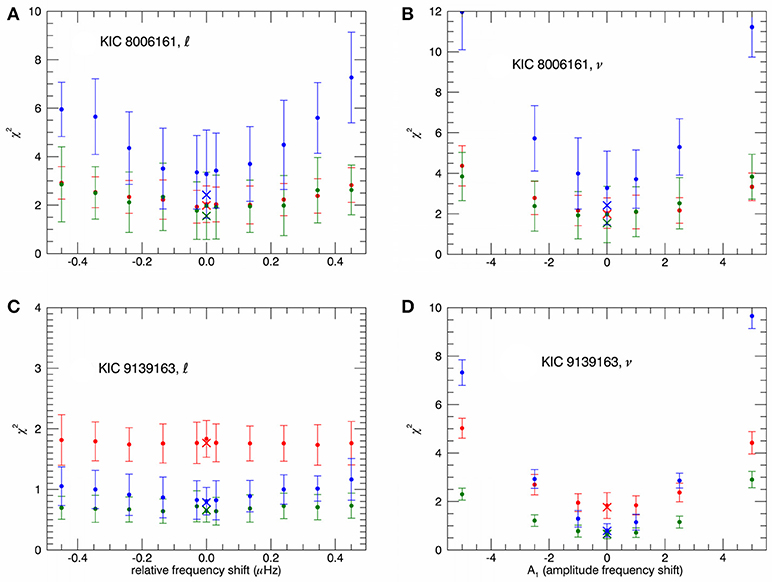
Figure 5. Merit function χ2 as a function of the frequency shift introduced for KIC8006161 (A,B) and for KIC9139163 (C,D). Here ℓ or ν indicates if the shift considered was ℓ or ν dependent. Red points correspond to adding the frequency shifts to the actual stellar data, green points correspond to adding the frequency shifts to the proxy with the same frequency errors and blue points correspond to the proxy with half of the observed frequency errors. The magnitudes shown in the X-axes are explained in section 3.1 and 3.2 (see also section 5.2).
On the other hand for the ν-dependent cases the X-axis is the amplitude A1 of the oscillatory function introduced in Equation (1), as factors of the actual values found for each star (see Figure 4 for a graphic representation of the frequency shifts corresponding to x-values of 1 in panels B and D of Figure 5). At x = 0 there are again two values per star: the circle which include the A0 term and the cross corresponding to the result without frequency shifts.
Let us consider the simulations in panel A. The red points correspond to the χ2 values obtained by adding the frequency shifts to the actual stellar data and errors. In this case χ2 increases with the absolute value of the frequency shift introduced but the changes are within errors and could hardly indicate an incorrect fit even for the highest values (frequency shifts of 0.45μHz). For the proxy star with the same frequency errors (green points) we obtain a similar behavior. However, for the proxy star with half the frequency errors (blue points) the χ2 values clearly increase even when only the constant shift is considered; for frequency shifts higher than 0.3μHz they are above the 1-σ level. These kind of frequency shifts is within the range of observed values as shown in section 3, but presumably they will be only present at a given time of the magnetic activity.
The results for the frequency-dependent shifts (panel B of Figure 5) show that for the extreme changes (that is an oscillatory frequency shift with an amplitude 5 times those observed in KIC8006161) even when considering the actual stellar parameters and errors (red points) the χ2 increases significantly. For the proxy with half the errors (blue points) even amplitudes of 2.5A1 could lead to an incorrect model fit.
For KIC9139163 the results on the oscillatory dependent term are similar (panel D) to the first star, however for the ℓ-dependent case (panel C) it seems that an acceptable fit is always obtained.
As a conclusion, an analysis based on the merit function χ2 cannot identify a bad model fit if we introduce a ν-dependent shift with an amplitude A1 for the oscillatory component smaller that 2.5 times the observed one. On the other hand, any value considered in this work for the ℓ-dependent shift can be identified as a bad fit, except for the ~ 1M⊙ case (KIC8006161) and assuming frequencies errors half the observed ones.
Despite the different χ2 values found above, the stellar parameters derived for the proxy with the full errors and half errors gives very similar results, so from now on we will only show results for the proxy with half the actual errors.
We first derived the stellar parameters from the minimization procedure after introducing the ℓ-dependent frequency shift (see Figure 6 for KIC8006161). For some of the parameters the changes induced by the frequency shifts are higher than the formal uncertainties. In particular for the age we find a clear trend with a decrease of ~ 3.5% every 0.1μHz of increase in the difference between the frequency shifts of radial and non-radial modes. Thus, for such a star where different ℓ are experiencing different frequency shifts due to magnetic activity, the age estimate can be more than 10% away from the real age of the star. This can be compared with the uncertainties of 3% when using the actual frequencies and errors as well as the 1% uncertainty for the proxy with half frequency errors. Qualitatively, these results can be understood in terms of the associated change in the small separation that when using spherically symmetric models can only be interpreted in terms of changes in the stellar core. For the mass and radius the changes are smaller, of the same size than typical (formal) uncertainties. Specifically there is an increase of ~ 1% per 0.1μHz in the mass and of ~ 0.3% per 0.1μHz in the radius that are of the same order as the formal uncertainties given in Table 2.
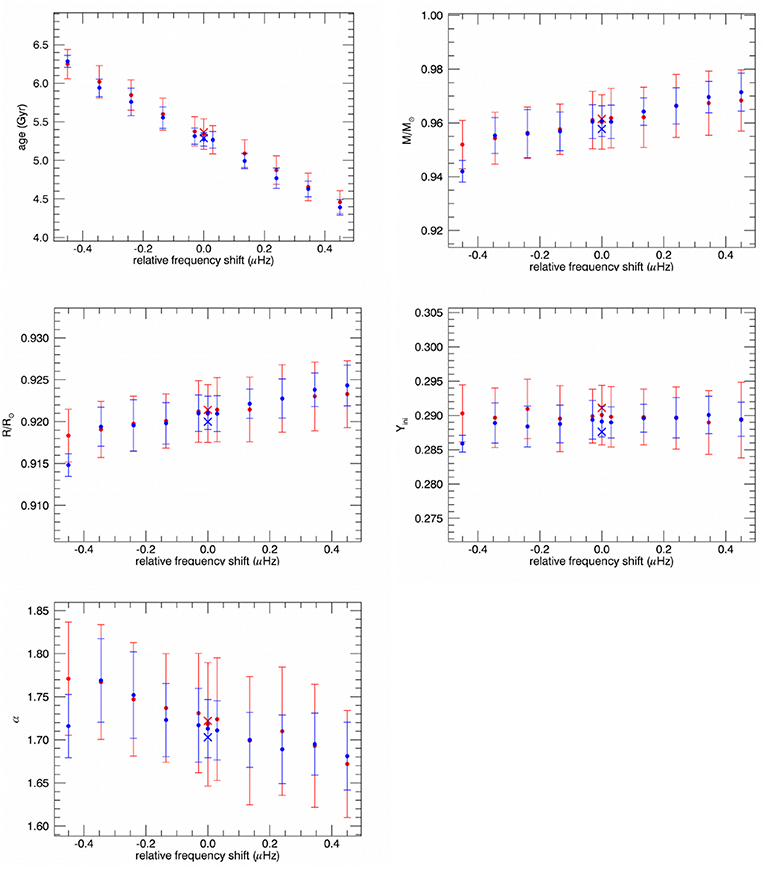
Figure 6. Stellar parameters derived from the minimization procedure as a function of the ℓ-dependent frequency shift introduced in the frequencies. Red points are for KIC8006161 whereas blue points corresponds to the proxy.
Figure 7 shows the results when an ℓ-dependent frequency shift is introduced in the eigenfrequencies of KIC9139163. In this case, the frequency shifts do not change the results by more than the formal uncertainties, except perhaps for the overshooting parameter fov for which we find changes of 0.02, above the 1-σ level.
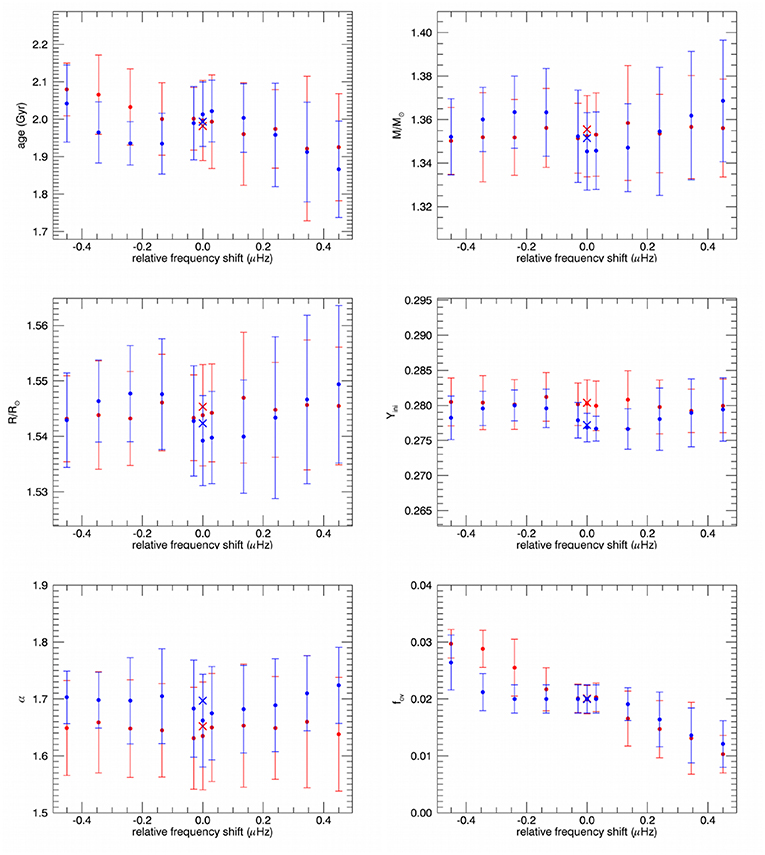
Figure 7. Stellar parameters derived from the minimization procedure as a function of the ℓ-dependent frequency shift introduced in the frequencies. Red points are for KIC9139163 whereas blue points corresponds to the proxy.
Let us now consider the frequency dependent changes discussed in section 3. In Figure 8 we show the results for KIC8006161. Remember that in this case X-axis correspond to the amplitude A1 in Equation (1) in times the A1 value derived from the observations. There are two points with A1 = 0, the cross corresponding to the modes without any frequency shift (A0 = 0 in Equation 1) and the dot corresponding to a frequency shift with the constant coefficient A0 ≠ 0 derived by Salabert et al. (2018) but with the oscillatory term removed.
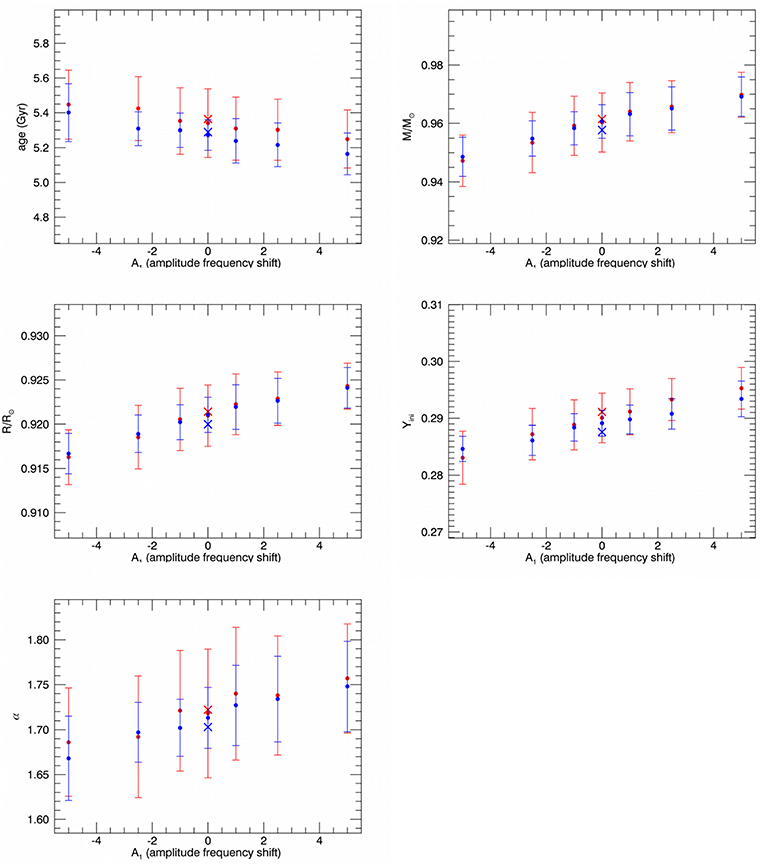
Figure 8. Stellar parameters derived from the minimization procedure as a function of the ν-dependent frequency shift introduced in the frequencies. Red points are for KIC8006161 whereas blue points corresponds to the proxy.
In this case, the changes in the age estimate are within the error bars. However, there is a clear increasing trend in the mass, radius, and initial helium abundance. Specifically by taking A1 equals to the observed value, the age decreases by 0.4%, the mass increases by ~ 0.6%, the radius by ~ 0.15%, and the helium abundance by ΔYini ~ 0.002 (1%). These numbers are in practice below typical errors and could hardly be discriminated from other source of errors. In principle for large oscillatory amplitudes (higher values of A1) the changes could be more relevant, ΔYini ~ 0.01 (5%). However, as discussed early, these larger changes would result in high χ2 values, which would allow us to identify an incorrect model fit.
Figure 9 shows the results for KIC9139163. In this case the frequency shifts introduced do not change the results by more than the formal uncertainties though like KIC 8006161, similar trends in the age, mass, and radius can be seen.
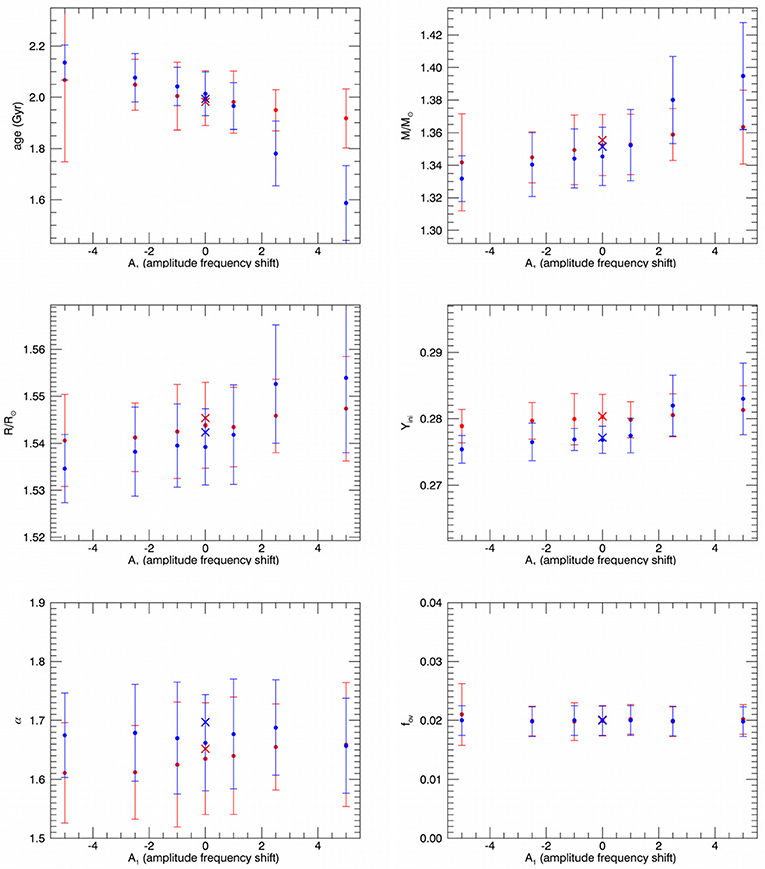
Figure 9. Stellar parameter derived from the minimization procedure as a function of the ν-dependent frequency shift introduced in the frequencies. Red points are for KIC9139163 whereas blue points corresponds to the proxy.
Quantifying the influence of the frequency shifts caused by the magnetic activity on the determination of the stellar parameters with asteroseismic techniques cannot be expressed with a simple mathematical rule because most of the techniques rely on some kind of model fitting that includes different constraints on a multiple parameter problem. For instance, quite different results could be obtained if one deals with the overshooting by introducing a free parameter or if it is fixed a priori. The same can be true when considering the helium and metallicity abundances, they can be implemented as two independent parameters or they can be coupled through a ΔY/ΔZ enrichment law. Moreover, if rather than a direct comparison between observed and theoretical frequencies, derived quantities are used to determine some specific parameters (e.g., see Verma et al., 2019 for using the acoustic glitches to determine the helium abundance) then the sensibility to the magnetic perturbations can also be different. In this work we have not tried to consider a broad range of situations but rather limit the analysis to some few examples, which we believe can be representative of some model fitting procedures. Although generalizing our quantitative results to other cases should not be correct, we hope that our results can at least serve as order-of-magnitude guidance for a large range of cases.
If observations are limited to periods of months, magnetic activity can cause mode frequencies to depart from their raw values by tenths of μHz or even more. We found that an ℓ-dependent shift due to magnetic activity similar to that reported in Santos et al. (2018) can introduce errors in the age of the order of 10% at most, and of a few percents in the mass and radius. These figures can be higher than formal uncertainties and in particular we found that the uncertainties were more relevant for the 1M⊙ example than for the 1.4M⊙ case. In principle one can think that this result could be due to the different quality of the input parameters in particular because KIC8006161 has a larger range of frequencies, including some ℓ = 3 modes, but we have checked that limiting the frequency modes of this star to a range similar to the observed one for KIC9139163 leads to very similar results. Hence it seems that the different positions in the HR-diagram should be the cause of the higher influence of the magnetic activity on the determination of the stellar parameters (relative to errors).
As long as surface uncertainties remain significant in the models, the frequency dependence of the frequencies shifts induced by the magnetic activity would be partially masked by the filtering procedures required in the modeling. However, as shown by Salabert et al. (2018), the frequency shifts can include an oscillatory component of a period similar to that corresponding to the acoustic depth of the He II zone, which would not be suppressed by the surface filtering. These shifts can also give rise to a misdetermination of some global stellar parameters, as for instance the helium abundance. But we have found that the uncertainties introduced seem to be below the 3% level in all the parameter analyzed.
Reducing the uncertainties on the frequencies to half of the observed one improves the determination of the stellar parameters in one of the cases (KIC8006161) and potentially would allow to flag incorrect determination of the best-fit model as they seem to have high χ2 values.
FPH has made the simulations and do the theoretical work. RG, SM, AS, and CR have worked on the observational side and obtained the variations with activity of the oscillation modes. All the authors contributed to the discussion written in the article and to the conclusions.
This research was supported in part by the Spanish MINECO under project ESP2015-65712-C5-4-R. The paper made use of the IAC Supercomputing facility HTCondor (http://research.cs.wisc.edu/htcondor/), partly financed by the MINECO with FEDER funds, code IACA13-3E-2493. RG acknowledge the support from PLATO and GOLF CNES grants. SM acknowledge support by the National Aeronautics and Space Administration under Grant NNX15AF13G, by the National Science Foundation grant 435 AST-1411685 and the Ramon y Cajal fellowship number RYC-2015-17697. AS acknowledges the support from National Aeronautics and Space Administration under Grant NNX17AF27G.
The authors declare that the research was conducted in the absence of any commercial or financial relationships that could be construed as a potential conflict of interest.
The reviewer AS declared a past co-authorship with the authors RG and SM to the handling editor.
Aerts, C., Christensen-Dalsgaard, J., and Kurtz, D. W. (2010). Asteroseismology. Dordrecht; Heidelberg; London; New York, NY: Springer. doi: 10.1007/978-1-4020-5803-5
Anders, F., Chiappini, C., Rodrigues, T. S., Miglio, A., Montalbán, J., Mosser, B., et al. (2016). Galactic archaeology with asteroseismology and spectroscopy: red giants observed by CoRoT and APOGEE. Astron. Astrophys. 597:A30. doi: 10.1051/0004-6361/201527204
Appourchaux, T., Chaplin, W. J., García, R. A., Gruberbauer, M., Verner, G. A., Antia, H. M., et al. (2012). Oscillation mode frequencies of 61 main-sequence and subgiant stars observed by Kepler. Astron. Astrophys. 543:A54. doi: 10.1051/0004-6361/201218948
Baglin, A., Auvergne, M., Boisnard, L., Lam-Trong, T., Barge, P., Catala, C., et al. (2006). “CoRoT: a high precision photometer for stellar ecolution and exoplanet finding,” in 36th COSPAR Scientific Assembly, Vol. 36 of COSPAR, Plenary Meeting (Beijing), 3749.
Ball, W. H., and Gizon, L. (2017). Surface-effect corrections for oscillation frequencies of evolved stars. Astron. Astrophys. 600:A128. doi: 10.1051/0004-6361/201630260
Borucki, W. J., Koch, D., Basri, G., Batalha, N., Brown, T., Caldwell, D., et al. (2010). Kepler planet-detection mission: introduction and first results. Science 327, 977–980. doi: 10.1126/science.1185402
Broomhall, A.-M., Chatterjee, P., Howe, R., Norton, A. A., and Thompson, M. J. (2014). The Sun's interior structure and dynamics, and the Solar cycle. Space Sci. Rev. 186, 191–225. doi: 10.1007/s11214-014-0101-3
Brown, T. M., Gilliland, R. L., Noyes, R. W., and Ramsey, L. W. (1991). Detection of possible p-mode oscillations on Procyon. Astrophys. J. 368, 599–609. doi: 10.1086/169725
Brun, A. S., and Browning, M. K. (2017). Magnetism, dynamo action and the solar-stellar connection. Living Rev. Solar Phys. 14:4. doi: 10.1007/s41116-017-0007-8
Chaplin, W. J., Kjeldsen, H., Bedding, T. R., Christensen-Dalsgaard, J., Gilliland, R. L., Kawaler, S. D., et al. (2011). Predicting the detectability of oscillations in solar-type stars observed by Kepler. Astrophys. J. 732:54. doi: 10.1088/0004-637X/732/1/54
Christensen-Dalsgaard, J. (2008). ADIPLS: the Aarhus adiabatic oscillation package. Astrophys. Space Sci. 316, 113–120. doi: 10.1007/s10509-007-9689-z
Creevey, O. L., Metcalfe, T. S., Schultheis, M., Salabert, D., Bazot, M., Thévenin, F., et al. (2017). Characterizing solar-type stars from full-length Kepler data sets using the Asteroseismic Modeling Portal. Astron. Astrophys. 601:A67. doi: 10.1051/0004-6361/201629496
Freytag, B., Ludwig, H.-G., and Steffen, M. (1996). Hydrodynamical models of stellar convection. The role of overshoot in DA white dwarfs, A-type stars, and the Sun. Astron. Astrophys. 313, 497–516.
García, R. A., Ceillier, T., Salabert, D., Mathur, S., van Saders, J. L., Pinsonneault, M., et al. (2014). Rotation and magnetism of Kepler pulsating solar-like stars. Towards asteroseismically calibrated age-rotation relations. Astron. Astrophys. 572:A34. doi: 10.1051/0004-6361/201423888
García, R. A., Mathur, S., Salabert, D., Ballot, J., Régulo, C., Metcalfe, T. S., et al. (2010). CoRoT reveals a magnetic activity cycle in a sun-like star. Science 329:1032. doi: 10.1126/science.1191064
Goldreich, P., and Keeley, D. A. (1977). Solar seismology. II - The stochastic excitation of the solar p-modes by turbulent convection. Astrophys. J. 212, 243–251. doi: 10.1086/155043
Grevesse, N., and Sauval, A. J. (1998). Standard solar composition. Space Sci. Rev. 85, 161–174. doi: 10.1023/A:1005161325181
Herwig, F. (2000). The evolution of AGB stars with convective overshoot. Astron. Astrophys. 360, 952–968.
Howe, R., Basu, S., Davies, G. R., Ball, W. H, Chaplin, W. J, Elsworth, Y., et al. (2017). Parametrizing the time variation of the ‘surface term’ of stellar p-mode frequencies: application to helioseismic data Mon. Notices R. Astron. Soc. 464, 4777–4788. doi: 10.1093/mnras/stw2668
Howell, S. B., Sobeck, C., Haas, M., Still, M., Barclay, T., Mullally, F., et al. (2014). The K2 mission: characterization and early results. Publ. Astron. Soc. Pac. 126, 398–408. doi: 10.1086/676406
Huber, D., Chaplin, W. J., Christensen-Dalsgaard, J., Gilliland, R. L., Kjeldsen, H., Buchhave, L. A., et al. (2013). Fundamental properties of Kepler planet-candidate host stars using asteroseismology. Astrophys. J. 767:127. doi: 10.1088/0004-637X/767/2/127
Iglesias, C. A., and Rogers, F. J. (1996). Updated opal opacities. Astrophys. J. 464:943. doi: 10.1086/177381
Kallinger, T., Weiss, W. W., Barban, C., Baudin, F., Cameron, C., Carrier, F., et al. (2010). Oscillating red giants in the CoRoT exofield: asteroseismic mass and radius determination. Astron. Astrophys. 509:A77. doi: 10.1051/0004-6361/200811437
Karoff, C., Metcalfe, T. S., Santos, Â. R. G., Montet, B. T., Isaacson, H., Witzke, V., et al. (2018). The influence of metallicity on stellar differential rotation and magnetic activity. Astrophys. J. 852:46. doi: 10.3847/1538-4357/aaa026
Kawaler, S. D. (1988). Angular momentum loss in low-mass stars. Astrophys. J. 333, 236–247. doi: 10.1086/166740
Kiefer, R., Schad, A., Davies, G., and Roth, M. (2017). Stellar magnetic activity and variability of oscillation parameters: an investigation of 24 solar-like stars observed by Kepler. Astron. Astrophys. 598:A77. doi: 10.1051/0004-6361/201628469
Kjeldsen, H., and Bedding, T. R. (1995). Amplitudes of stellar oscillations: the implications for asteroseismology. Astron. Astrophys. 293, 87–106.
Kjeldsen, H., Bedding, T. R., and Christensen-Dalsgaard, J. (2008). Correcting stellar oscillation frequencies for near-surface effects. Astrophys. J. Lett. 683, L175–L178. doi: 10.1086/591667
Lebreton, Y., Goupil, M. J., and Montalbán, J. (2014a). “How accurate are stellar ages based on stellar models?. I. The impact of stellar models uncertainties,” in EAS Publications Series, Vol. 65 (Roscoff), 99–176.
Lebreton, Y., Goupil, M. J., and Montalbán, J. (2014b). “How accurate are stellar ages based on stellar models?. II. The impact of asteroseismology,” in EAS Publications Series, Vol. 65 (Roscoff), 177–223.
Libbrecht, K. G. (1992). On the ultimate accuracy of solar oscillation frequency measurements. Astrophys. J. 387, 712–714. doi: 10.1086/171119
Mathur, S., Metcalfe, T. S., Woitaszek, M., Bruntt, H., Verner, G. A., Christensen-Dalsgaard, J., et al. (2012). A uniform asteroseismic analysis of 22 solar-type stars observed by Kepler. Astrophys. J. 749:152. doi: 10.1088/0004-637X/749/2/152
Matt, S. P., MacGregor, K. B., Pinsonneault, M. H., and Greene, T. P. (2012). Magnetic braking formulation for sun-like stars: dependence on dipole field strength and rotation rate. Astrophys. J. Lett. 754:L26. doi: 10.1088/2041-8205/754/2/L26
Metcalfe, T. S., Creevey, O. L., Doğan, G., Mathur, S., Xu, H., Bedding, T. R., et al. (2014). Properties of 42 solar-type Kepler targets from the asteroseismic modeling portal. Astrophys. J. Suppl. Ser. 214:27. doi: 10.1088/0067-0049/214/2/27
Miglio, A., Chiappini, C., Morel, T., Barbieri, M., Chaplin, W. J., Girardi, L., et al. (2013). Galactic archaeology: mapping and dating stellar populations with asteroseismology of red-giant stars. Mon. Notices R. Astron. Soc. 429, 423–428. doi: 10.1093/mnras/sts345
Miglio, A., Girardi, L., Rodrigues, T. S., Stello, D., and Chaplin, W. J. (2015). “Solar-like oscillating stars as standard clocks and rulers for galactic studies,” in Asteroseismology of Stellar Populations in the Milky Way, Vol. 39 of Astrophysics and Space Science Proceedings, eds A. Miglio, P. Eggenberger, L. Girardi, and J. Montalbán, 11.
Pallé, P. L., Régulo, C., and Roca Cortés, T. (1989). Solar cycle induced variations of the low L solar acoustic spectrum. Astron. Astrophys. 224, 253–258.
Paxton, B., Bildsten, L., Dotter, A., Herwig, F., Lesaffre, P., and Timmes, F. (2011). Modules for experiments in stellar astrophysics (MESA). Astrophys. J. Suppl. Ser. 192:3. doi: 10.1088/0067-0049/192/1/3
Paxton, B., Cantiello, M., Arras, P., Bildsten, L., Brown, E. F., Dotter, A., et al. (2013). Modules for experiments in stellar astrophysics (MESA): planets, oscillations, rotation, and massive stars. Astrophys. J. Suppl. Ser. 208:4. doi: 10.1088/0067-0049/208/1/4
Paxton, B., Marchant, P., Schwab, J., Bauer, E. B., Bildsten, L., Cantiello, M., et al. (2015). Modules for experiments in stellar astrophysics (MESA): binaries, pulsations, and explosions. Astrophys. J. Suppl. Ser. 220:15. doi: 10.1088/0067-0049/220/1/15
Pérez Hernández, F., García, R. A., Corsaro, E., Triana, S. A., and De Ridder, J. (2016). Asteroseismology of 19 low-luminosity red giant stars from Kepler. Astron. Astrophys. 591:A99. doi: 10.1051/0004-6361/201628311
Réville, V., Brun, A. S., Matt, S. P., Strugarek, A., and Pinto, R. F. (2015). The effect of magnetic topology on thermally driven wind: toward a general formulation of the braking law. Astrophys. J. 798:116. doi: 10.1088/0004-637X/798/2/116
Ricker, G. R., Winn, J. N., Vanderspek, R., Latham, D. W., Bakos, G. Á., Bean, J. L., et al. (2014). “Transiting Exoplanet Survey Satellite (TESS),” in Society of Photo-Optical Instrumentation Engineers (SPIE) Conference Series, Vol. 9143 of Society of Photo-Optical Instrumentation Engineers (SPIE) Conference Series (Montréal, QC), 20.
Salabert, D., Régulo, C., García, R. A., Beck, P. G., Ballot, J., Creevey, O. L., et al. (2016). Magnetic variability in the young solar analog KIC 10644253. Observations from the Kepler satellite and the HERMES spectrograph. Astron. Astrophys. 589:A118. doi: 10.1051/0004-6361/201527978
Salabert, D., Régulo, C., Pérez Hernández, F., and García, R. A. (2018). Frequency dependence of p-mode frequency shifts induced by magnetic activity in Kepler solar-like stars. Astron. Astrophys. 611:A84. doi: 10.1051/0004-6361/201731714
Santos, A. R. G., Campante, T. L., Chaplin, W. J., Cunha, M. S., Lund, M. N., Kiefer, R., et al. (2018). Signatures of magnetic activity in the seismic data of solar-type stars observed by Kepler. Astrophys. J. Suppl. Ser. 237:17. doi: 10.3847/1538-4365/aac9b6
Serenelli, A., Johnson, J., Huber, D., Pinsonneault, M., Ball, W. H., Tayar, J., et al. (2017). The first APOKASC catalog of kepler dwarf and subgiant stars. Astrophys. J. Suppl. Ser. 233:23. doi: 10.3847/1538-4365/aa97df
Silva Aguirre, V., Davies, G. R., Basu, S., Christensen-Dalsgaard, J., Creevey, O., Metcalfe, T. S., et al. (2015). Ages and fundamental properties of Kepler exoplanet host stars from asteroseismology. Mon. Notices R. Astron. Soc. 452, 2127–2148. doi: 10.1093/mnras/stv1388
Skumanich, A. (1972). Time scales for CA II emission decay, rotational braking, and lithium depletion. Astrophys. J 171:565. doi: 10.1086/151310
Toutain, T., and Appourchaux, T. (1994). Maximum likelihood estimators: an application to the estimation of the precision of helioseismic measurements. Astron. Astrophys. 289, 649–658.
Trampedach, R., Aarslev, M. J., Houdek, G., Collet, R., Christensen-Dalsgaard, J., Stein, R. F., et al. (2017). The asteroseismic surface effect from a grid of 3D convection simulations - I. Frequency shifts from convective expansion of stellar atmospheres. Mon. Notices R. Astron. Soc. 466, L43–L47. doi: 10.1093/mnrasl/slw230
Van Eylen, V., Agentoft, C., Lundkvist, M. S., Kjeldsen, H., Owen, J. E., Fulton, B. J., et al. (2018a). An asteroseismic view of the radius valley: stripped cores, not born rocky. Mon. Notices R. Astron. Soc.479, 4786–4795. doi: 10.1093/mnras/sty1783
Van Eylen, V., Dai, F., Mathur, S., Gandolfi, D., Albrecht, S., Fridlund, M., et al. (2018b). HD 89345: a bright oscillating star hosting a transiting warm Saturn-sized planet observed by K2. Mon. Notices R. Astron. Soc. 478, 4866–4880. doi: 10.1093/mnras/sty1390
Verma, K., Raodeo, K., Basu, S., Silva Aguirre, V., Mazumdar, A., Mosumgaard, J. R., et al. (2019). Helium abundance in a sample of cool stars: measurements from asteroseismology. Mon. Notices R. Astron. Soc. 483, 4678–4694. doi: 10.1093/mnras/sty3374
Keywords: stars, asteroseismology, stellar magnetic activity, KIC 8006161, KIC 9139163
Citation: Pérez Hernández F, García RA, Mathur S, Santos ARG and Régulo C (2019) Influence of Magnetic Activity on the Determination of Stellar Parameters Through Asteroseismology. Front. Astron. Space Sci. 6:41. doi: 10.3389/fspas.2019.00041
Received: 05 December 2018; Accepted: 15 May 2019;
Published: 31 May 2019.
Edited by:
Markus Roth, Kiepenheuer Institut für Sonnenphysik, Albert Ludwigs Universität Freiburg, GermanyReviewed by:
Aldo Serenelli, Institute of Space Sciences (ICE), SpainCopyright © 2019 Pérez Hernández, García, Mathur, Santos and Régulo. This is an open-access article distributed under the terms of the Creative Commons Attribution License (CC BY). The use, distribution or reproduction in other forums is permitted, provided the original author(s) and the copyright owner(s) are credited and that the original publication in this journal is cited, in accordance with accepted academic practice. No use, distribution or reproduction is permitted which does not comply with these terms.
*Correspondence: Fernando Pérez Hernández, ZnBoQGlhYy5lcw==
Disclaimer: All claims expressed in this article are solely those of the authors and do not necessarily represent those of their affiliated organizations, or those of the publisher, the editors and the reviewers. Any product that may be evaluated in this article or claim that may be made by its manufacturer is not guaranteed or endorsed by the publisher.
Research integrity at Frontiers

Learn more about the work of our research integrity team to safeguard the quality of each article we publish.